PAR5010-B Assessment: Physiotherapy Interventions for Low Back Pain
VerifiedAdded on 2023/04/21
|7
|1991
|392
Report
AI Summary
This report critically evaluates the evidence base for using exercise as a physiotherapeutic intervention for low back pain (LBP), particularly in the context of lumbar disc herniation. It references NICE guidelines and analyzes various studies, including systematic reviews and randomized controlled trials, to determine the effectiveness of different exercise types (aerobic, strength, motor control). The analysis considers factors like the chronic nature of the pain, the impact on occupational status, and the importance of supervision. The report concludes that exercise is a suitable intervention for chronic LBP, with the specific type, intensity, and frequency tailored to the individual patient's needs, while also acknowledging limitations in existing research regarding specific exercise preferences and session formats. Desklib offers a wealth of similar solved assignments and study resources for students.
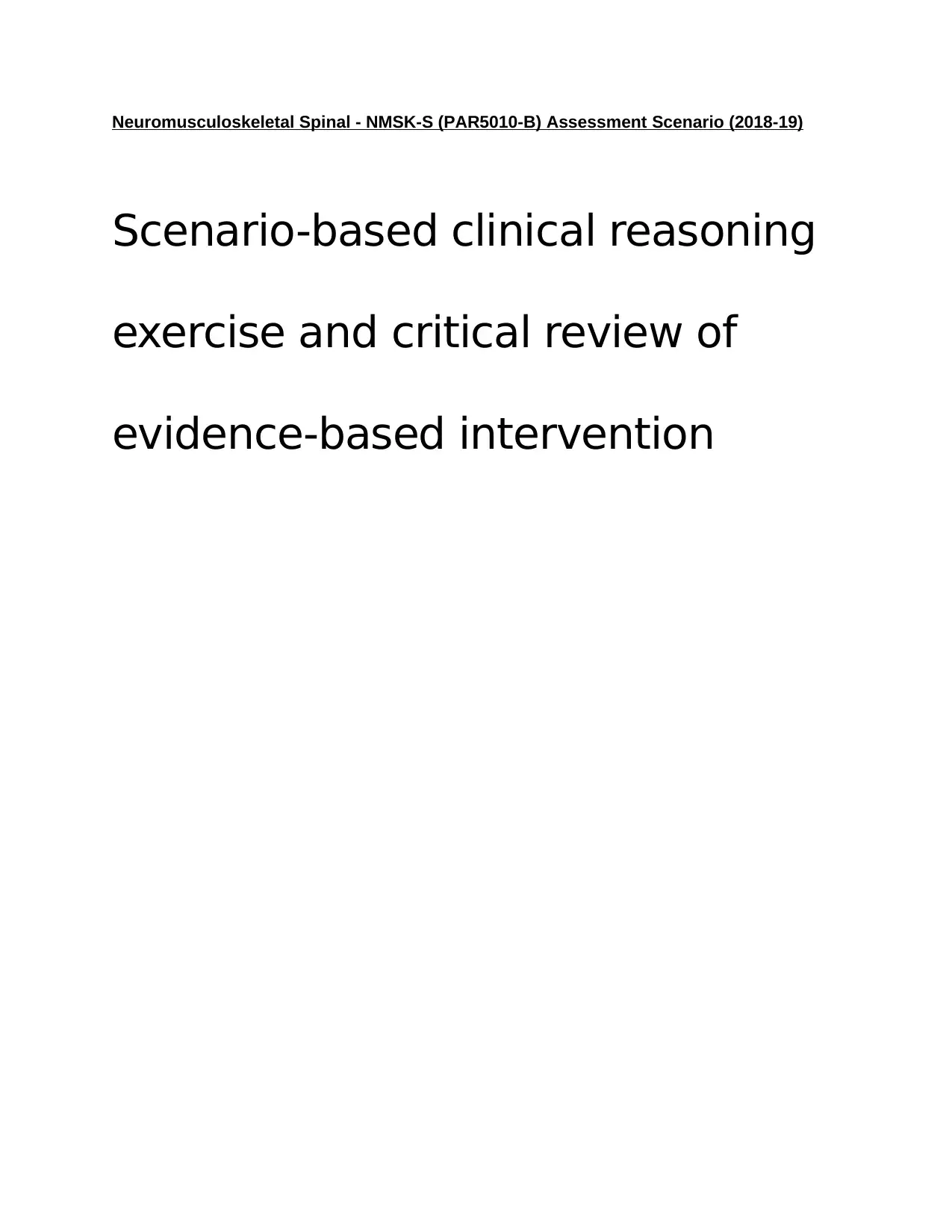
Neuromusculoskeletal Spinal - NMSK-S (PAR5010-B) Assessment Scenario (2018-19)
Scenario-based clinical reasoning
exercise and critical review of
evidence-based intervention
Scenario-based clinical reasoning
exercise and critical review of
evidence-based intervention
Paraphrase This Document
Need a fresh take? Get an instant paraphrase of this document with our AI Paraphraser
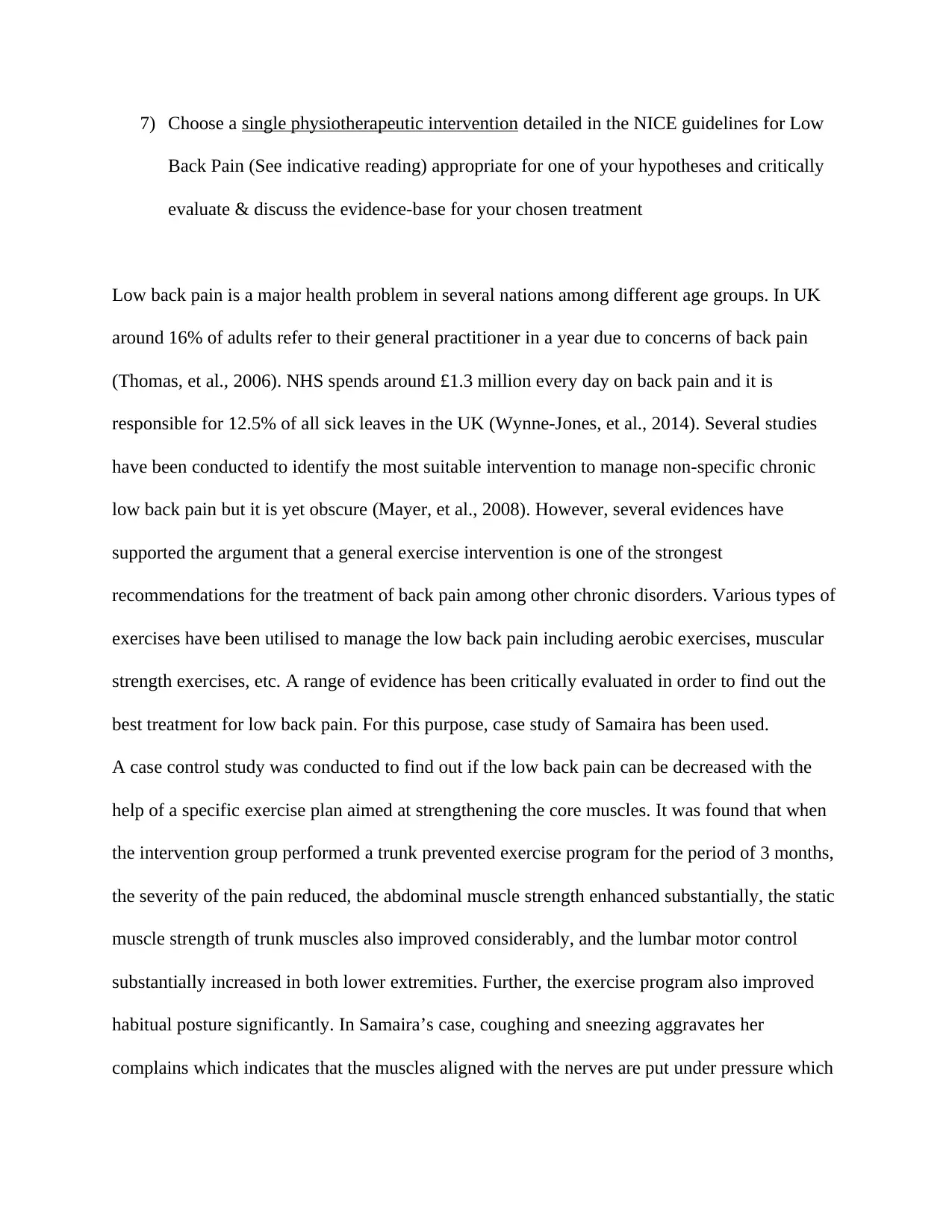
7) Choose a single physiotherapeutic intervention detailed in the NICE guidelines for Low
Back Pain (See indicative reading) appropriate for one of your hypotheses and critically
evaluate & discuss the evidence-base for your chosen treatment
Low back pain is a major health problem in several nations among different age groups. In UK
around 16% of adults refer to their general practitioner in a year due to concerns of back pain
(Thomas, et al., 2006). NHS spends around £1.3 million every day on back pain and it is
responsible for 12.5% of all sick leaves in the UK (Wynne-Jones, et al., 2014). Several studies
have been conducted to identify the most suitable intervention to manage non-specific chronic
low back pain but it is yet obscure (Mayer, et al., 2008). However, several evidences have
supported the argument that a general exercise intervention is one of the strongest
recommendations for the treatment of back pain among other chronic disorders. Various types of
exercises have been utilised to manage the low back pain including aerobic exercises, muscular
strength exercises, etc. A range of evidence has been critically evaluated in order to find out the
best treatment for low back pain. For this purpose, case study of Samaira has been used.
A case control study was conducted to find out if the low back pain can be decreased with the
help of a specific exercise plan aimed at strengthening the core muscles. It was found that when
the intervention group performed a trunk prevented exercise program for the period of 3 months,
the severity of the pain reduced, the abdominal muscle strength enhanced substantially, the static
muscle strength of trunk muscles also improved considerably, and the lumbar motor control
substantially increased in both lower extremities. Further, the exercise program also improved
habitual posture significantly. In Samaira’s case, coughing and sneezing aggravates her
complains which indicates that the muscles aligned with the nerves are put under pressure which
Back Pain (See indicative reading) appropriate for one of your hypotheses and critically
evaluate & discuss the evidence-base for your chosen treatment
Low back pain is a major health problem in several nations among different age groups. In UK
around 16% of adults refer to their general practitioner in a year due to concerns of back pain
(Thomas, et al., 2006). NHS spends around £1.3 million every day on back pain and it is
responsible for 12.5% of all sick leaves in the UK (Wynne-Jones, et al., 2014). Several studies
have been conducted to identify the most suitable intervention to manage non-specific chronic
low back pain but it is yet obscure (Mayer, et al., 2008). However, several evidences have
supported the argument that a general exercise intervention is one of the strongest
recommendations for the treatment of back pain among other chronic disorders. Various types of
exercises have been utilised to manage the low back pain including aerobic exercises, muscular
strength exercises, etc. A range of evidence has been critically evaluated in order to find out the
best treatment for low back pain. For this purpose, case study of Samaira has been used.
A case control study was conducted to find out if the low back pain can be decreased with the
help of a specific exercise plan aimed at strengthening the core muscles. It was found that when
the intervention group performed a trunk prevented exercise program for the period of 3 months,
the severity of the pain reduced, the abdominal muscle strength enhanced substantially, the static
muscle strength of trunk muscles also improved considerably, and the lumbar motor control
substantially increased in both lower extremities. Further, the exercise program also improved
habitual posture significantly. In Samaira’s case, coughing and sneezing aggravates her
complains which indicates that the muscles aligned with the nerves are put under pressure which
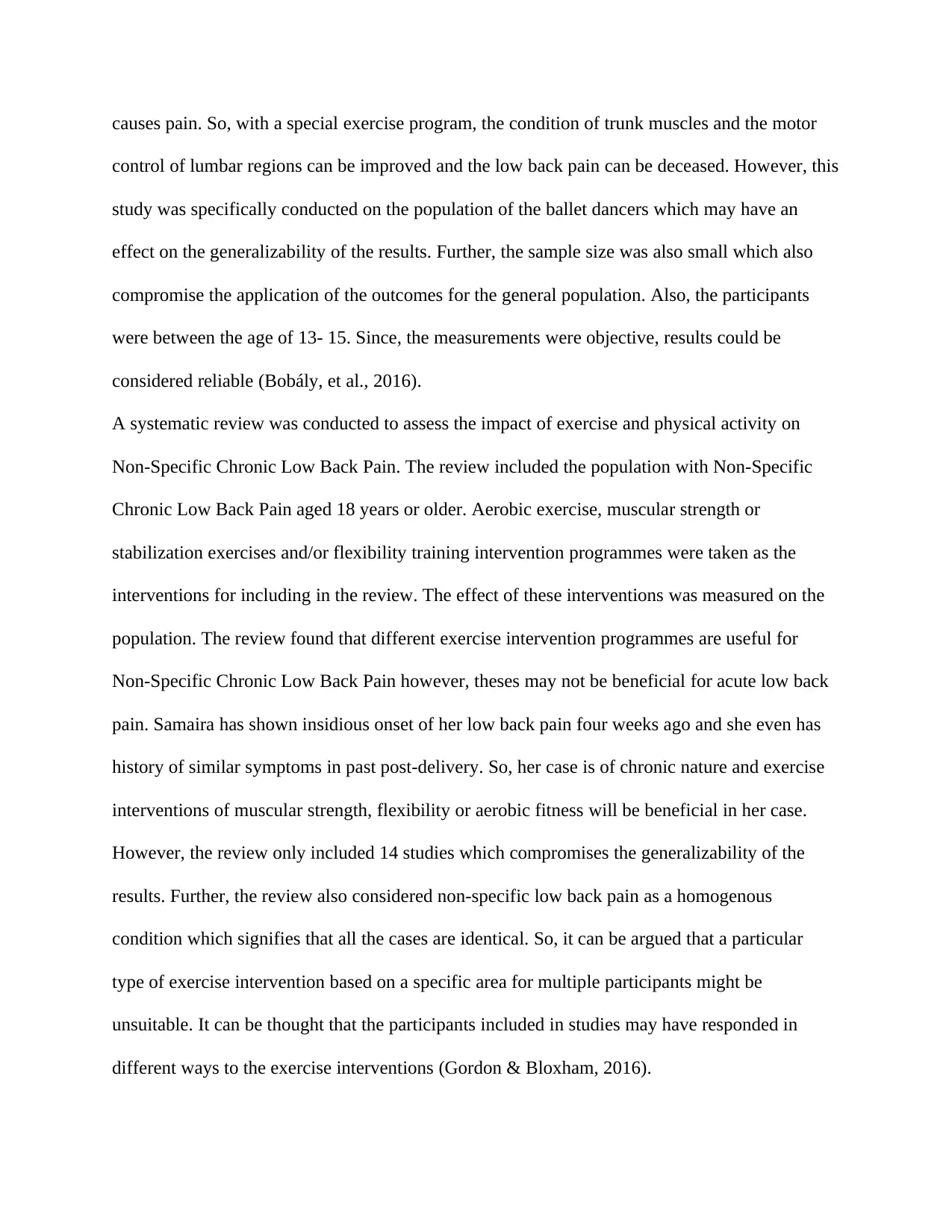
causes pain. So, with a special exercise program, the condition of trunk muscles and the motor
control of lumbar regions can be improved and the low back pain can be deceased. However, this
study was specifically conducted on the population of the ballet dancers which may have an
effect on the generalizability of the results. Further, the sample size was also small which also
compromise the application of the outcomes for the general population. Also, the participants
were between the age of 13- 15. Since, the measurements were objective, results could be
considered reliable (Bobály, et al., 2016).
A systematic review was conducted to assess the impact of exercise and physical activity on
Non-Specific Chronic Low Back Pain. The review included the population with Non-Specific
Chronic Low Back Pain aged 18 years or older. Aerobic exercise, muscular strength or
stabilization exercises and/or flexibility training intervention programmes were taken as the
interventions for including in the review. The effect of these interventions was measured on the
population. The review found that different exercise intervention programmes are useful for
Non-Specific Chronic Low Back Pain however, theses may not be beneficial for acute low back
pain. Samaira has shown insidious onset of her low back pain four weeks ago and she even has
history of similar symptoms in past post-delivery. So, her case is of chronic nature and exercise
interventions of muscular strength, flexibility or aerobic fitness will be beneficial in her case.
However, the review only included 14 studies which compromises the generalizability of the
results. Further, the review also considered non-specific low back pain as a homogenous
condition which signifies that all the cases are identical. So, it can be argued that a particular
type of exercise intervention based on a specific area for multiple participants might be
unsuitable. It can be thought that the participants included in studies may have responded in
different ways to the exercise interventions (Gordon & Bloxham, 2016).
control of lumbar regions can be improved and the low back pain can be deceased. However, this
study was specifically conducted on the population of the ballet dancers which may have an
effect on the generalizability of the results. Further, the sample size was also small which also
compromise the application of the outcomes for the general population. Also, the participants
were between the age of 13- 15. Since, the measurements were objective, results could be
considered reliable (Bobály, et al., 2016).
A systematic review was conducted to assess the impact of exercise and physical activity on
Non-Specific Chronic Low Back Pain. The review included the population with Non-Specific
Chronic Low Back Pain aged 18 years or older. Aerobic exercise, muscular strength or
stabilization exercises and/or flexibility training intervention programmes were taken as the
interventions for including in the review. The effect of these interventions was measured on the
population. The review found that different exercise intervention programmes are useful for
Non-Specific Chronic Low Back Pain however, theses may not be beneficial for acute low back
pain. Samaira has shown insidious onset of her low back pain four weeks ago and she even has
history of similar symptoms in past post-delivery. So, her case is of chronic nature and exercise
interventions of muscular strength, flexibility or aerobic fitness will be beneficial in her case.
However, the review only included 14 studies which compromises the generalizability of the
results. Further, the review also considered non-specific low back pain as a homogenous
condition which signifies that all the cases are identical. So, it can be argued that a particular
type of exercise intervention based on a specific area for multiple participants might be
unsuitable. It can be thought that the participants included in studies may have responded in
different ways to the exercise interventions (Gordon & Bloxham, 2016).
⊘ This is a preview!⊘
Do you want full access?
Subscribe today to unlock all pages.

Trusted by 1+ million students worldwide
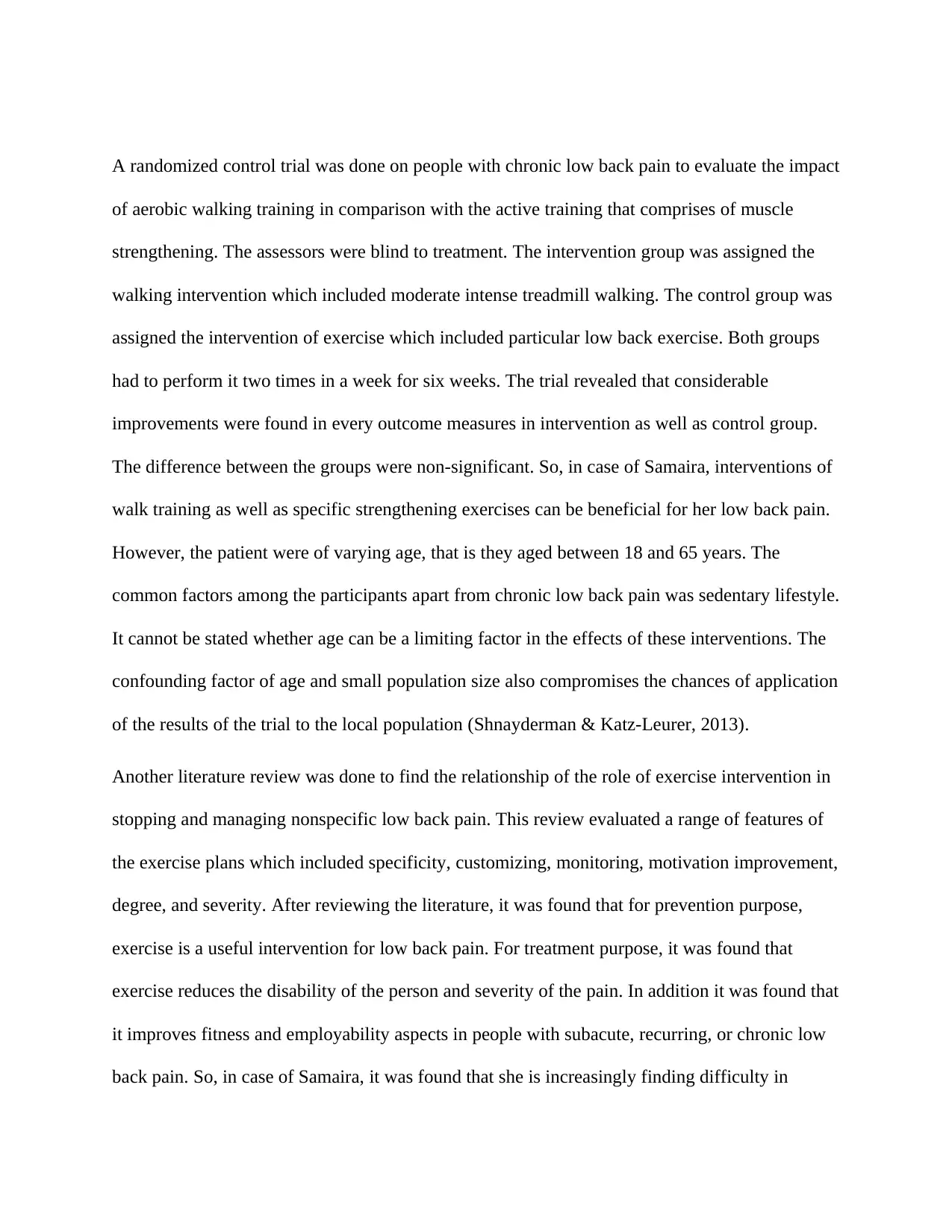
A randomized control trial was done on people with chronic low back pain to evaluate the impact
of aerobic walking training in comparison with the active training that comprises of muscle
strengthening. The assessors were blind to treatment. The intervention group was assigned the
walking intervention which included moderate intense treadmill walking. The control group was
assigned the intervention of exercise which included particular low back exercise. Both groups
had to perform it two times in a week for six weeks. The trial revealed that considerable
improvements were found in every outcome measures in intervention as well as control group.
The difference between the groups were non-significant. So, in case of Samaira, interventions of
walk training as well as specific strengthening exercises can be beneficial for her low back pain.
However, the patient were of varying age, that is they aged between 18 and 65 years. The
common factors among the participants apart from chronic low back pain was sedentary lifestyle.
It cannot be stated whether age can be a limiting factor in the effects of these interventions. The
confounding factor of age and small population size also compromises the chances of application
of the results of the trial to the local population (Shnayderman & Katz-Leurer, 2013).
Another literature review was done to find the relationship of the role of exercise intervention in
stopping and managing nonspecific low back pain. This review evaluated a range of features of
the exercise plans which included specificity, customizing, monitoring, motivation improvement,
degree, and severity. After reviewing the literature, it was found that for prevention purpose,
exercise is a useful intervention for low back pain. For treatment purpose, it was found that
exercise reduces the disability of the person and severity of the pain. In addition it was found that
it improves fitness and employability aspects in people with subacute, recurring, or chronic low
back pain. So, in case of Samaira, it was found that she is increasingly finding difficulty in
of aerobic walking training in comparison with the active training that comprises of muscle
strengthening. The assessors were blind to treatment. The intervention group was assigned the
walking intervention which included moderate intense treadmill walking. The control group was
assigned the intervention of exercise which included particular low back exercise. Both groups
had to perform it two times in a week for six weeks. The trial revealed that considerable
improvements were found in every outcome measures in intervention as well as control group.
The difference between the groups were non-significant. So, in case of Samaira, interventions of
walk training as well as specific strengthening exercises can be beneficial for her low back pain.
However, the patient were of varying age, that is they aged between 18 and 65 years. The
common factors among the participants apart from chronic low back pain was sedentary lifestyle.
It cannot be stated whether age can be a limiting factor in the effects of these interventions. The
confounding factor of age and small population size also compromises the chances of application
of the results of the trial to the local population (Shnayderman & Katz-Leurer, 2013).
Another literature review was done to find the relationship of the role of exercise intervention in
stopping and managing nonspecific low back pain. This review evaluated a range of features of
the exercise plans which included specificity, customizing, monitoring, motivation improvement,
degree, and severity. After reviewing the literature, it was found that for prevention purpose,
exercise is a useful intervention for low back pain. For treatment purpose, it was found that
exercise reduces the disability of the person and severity of the pain. In addition it was found that
it improves fitness and employability aspects in people with subacute, recurring, or chronic low
back pain. So, in case of Samaira, it was found that she is increasingly finding difficulty in
Paraphrase This Document
Need a fresh take? Get an instant paraphrase of this document with our AI Paraphraser
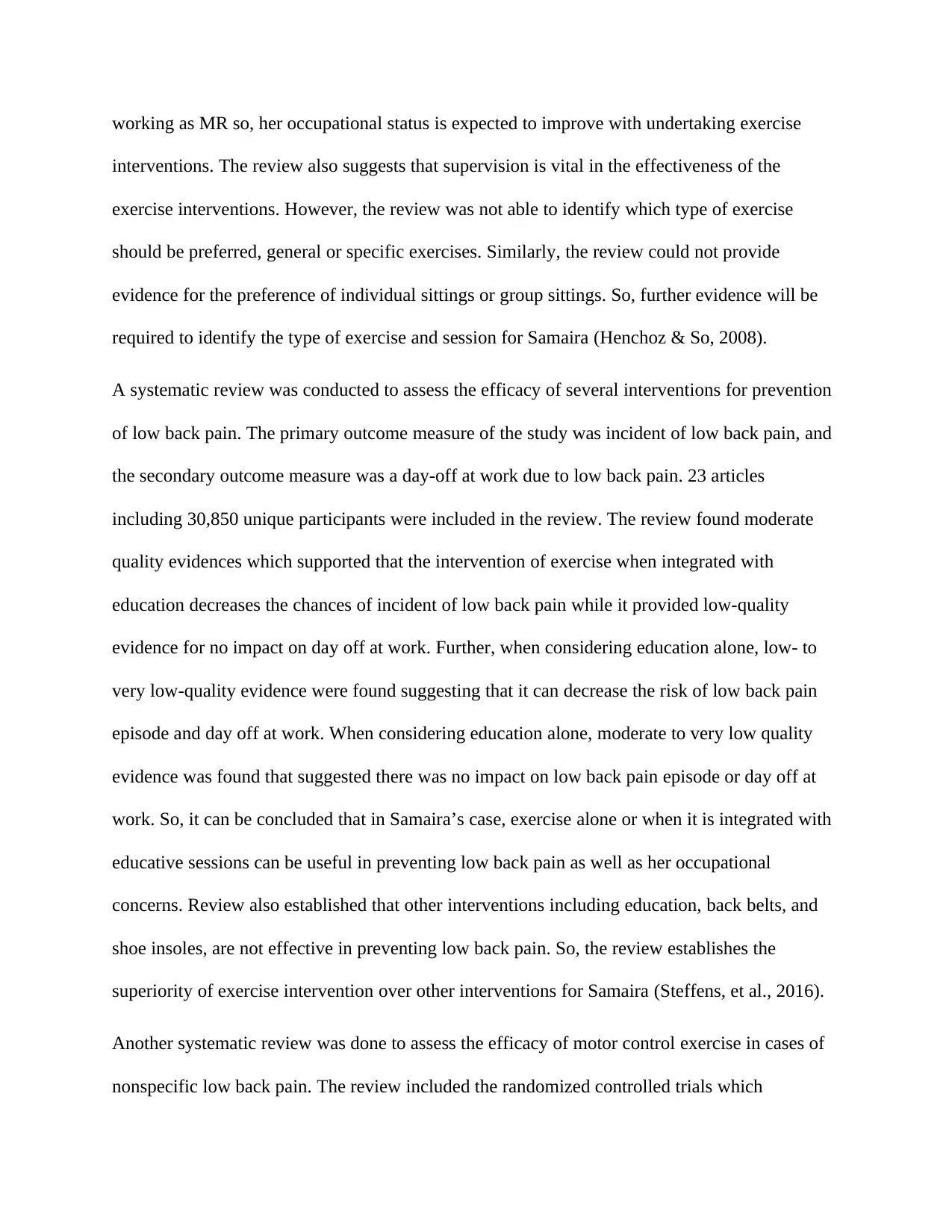
working as MR so, her occupational status is expected to improve with undertaking exercise
interventions. The review also suggests that supervision is vital in the effectiveness of the
exercise interventions. However, the review was not able to identify which type of exercise
should be preferred, general or specific exercises. Similarly, the review could not provide
evidence for the preference of individual sittings or group sittings. So, further evidence will be
required to identify the type of exercise and session for Samaira (Henchoz & So, 2008).
A systematic review was conducted to assess the efficacy of several interventions for prevention
of low back pain. The primary outcome measure of the study was incident of low back pain, and
the secondary outcome measure was a day-off at work due to low back pain. 23 articles
including 30,850 unique participants were included in the review. The review found moderate
quality evidences which supported that the intervention of exercise when integrated with
education decreases the chances of incident of low back pain while it provided low-quality
evidence for no impact on day off at work. Further, when considering education alone, low- to
very low-quality evidence were found suggesting that it can decrease the risk of low back pain
episode and day off at work. When considering education alone, moderate to very low quality
evidence was found that suggested there was no impact on low back pain episode or day off at
work. So, it can be concluded that in Samaira’s case, exercise alone or when it is integrated with
educative sessions can be useful in preventing low back pain as well as her occupational
concerns. Review also established that other interventions including education, back belts, and
shoe insoles, are not effective in preventing low back pain. So, the review establishes the
superiority of exercise intervention over other interventions for Samaira (Steffens, et al., 2016).
Another systematic review was done to assess the efficacy of motor control exercise in cases of
nonspecific low back pain. The review included the randomized controlled trials which
interventions. The review also suggests that supervision is vital in the effectiveness of the
exercise interventions. However, the review was not able to identify which type of exercise
should be preferred, general or specific exercises. Similarly, the review could not provide
evidence for the preference of individual sittings or group sittings. So, further evidence will be
required to identify the type of exercise and session for Samaira (Henchoz & So, 2008).
A systematic review was conducted to assess the efficacy of several interventions for prevention
of low back pain. The primary outcome measure of the study was incident of low back pain, and
the secondary outcome measure was a day-off at work due to low back pain. 23 articles
including 30,850 unique participants were included in the review. The review found moderate
quality evidences which supported that the intervention of exercise when integrated with
education decreases the chances of incident of low back pain while it provided low-quality
evidence for no impact on day off at work. Further, when considering education alone, low- to
very low-quality evidence were found suggesting that it can decrease the risk of low back pain
episode and day off at work. When considering education alone, moderate to very low quality
evidence was found that suggested there was no impact on low back pain episode or day off at
work. So, it can be concluded that in Samaira’s case, exercise alone or when it is integrated with
educative sessions can be useful in preventing low back pain as well as her occupational
concerns. Review also established that other interventions including education, back belts, and
shoe insoles, are not effective in preventing low back pain. So, the review establishes the
superiority of exercise intervention over other interventions for Samaira (Steffens, et al., 2016).
Another systematic review was done to assess the efficacy of motor control exercise in cases of
nonspecific low back pain. The review included the randomized controlled trials which
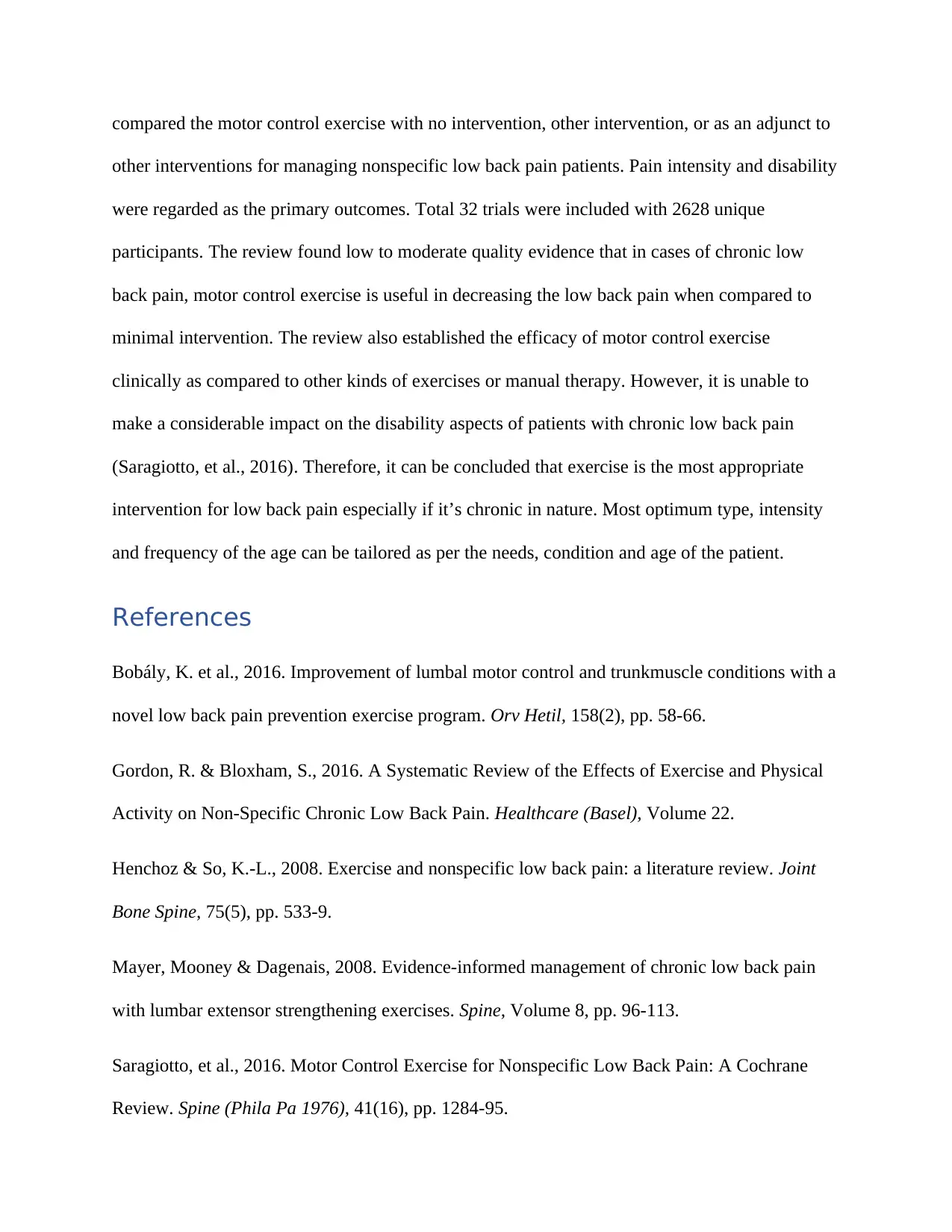
compared the motor control exercise with no intervention, other intervention, or as an adjunct to
other interventions for managing nonspecific low back pain patients. Pain intensity and disability
were regarded as the primary outcomes. Total 32 trials were included with 2628 unique
participants. The review found low to moderate quality evidence that in cases of chronic low
back pain, motor control exercise is useful in decreasing the low back pain when compared to
minimal intervention. The review also established the efficacy of motor control exercise
clinically as compared to other kinds of exercises or manual therapy. However, it is unable to
make a considerable impact on the disability aspects of patients with chronic low back pain
(Saragiotto, et al., 2016). Therefore, it can be concluded that exercise is the most appropriate
intervention for low back pain especially if it’s chronic in nature. Most optimum type, intensity
and frequency of the age can be tailored as per the needs, condition and age of the patient.
References
Bobály, K. et al., 2016. Improvement of lumbal motor control and trunkmuscle conditions with a
novel low back pain prevention exercise program. Orv Hetil, 158(2), pp. 58-66.
Gordon, R. & Bloxham, S., 2016. A Systematic Review of the Effects of Exercise and Physical
Activity on Non-Specific Chronic Low Back Pain. Healthcare (Basel), Volume 22.
Henchoz & So, K.-L., 2008. Exercise and nonspecific low back pain: a literature review. Joint
Bone Spine, 75(5), pp. 533-9.
Mayer, Mooney & Dagenais, 2008. Evidence-informed management of chronic low back pain
with lumbar extensor strengthening exercises. Spine, Volume 8, pp. 96-113.
Saragiotto, et al., 2016. Motor Control Exercise for Nonspecific Low Back Pain: A Cochrane
Review. Spine (Phila Pa 1976), 41(16), pp. 1284-95.
other interventions for managing nonspecific low back pain patients. Pain intensity and disability
were regarded as the primary outcomes. Total 32 trials were included with 2628 unique
participants. The review found low to moderate quality evidence that in cases of chronic low
back pain, motor control exercise is useful in decreasing the low back pain when compared to
minimal intervention. The review also established the efficacy of motor control exercise
clinically as compared to other kinds of exercises or manual therapy. However, it is unable to
make a considerable impact on the disability aspects of patients with chronic low back pain
(Saragiotto, et al., 2016). Therefore, it can be concluded that exercise is the most appropriate
intervention for low back pain especially if it’s chronic in nature. Most optimum type, intensity
and frequency of the age can be tailored as per the needs, condition and age of the patient.
References
Bobály, K. et al., 2016. Improvement of lumbal motor control and trunkmuscle conditions with a
novel low back pain prevention exercise program. Orv Hetil, 158(2), pp. 58-66.
Gordon, R. & Bloxham, S., 2016. A Systematic Review of the Effects of Exercise and Physical
Activity on Non-Specific Chronic Low Back Pain. Healthcare (Basel), Volume 22.
Henchoz & So, K.-L., 2008. Exercise and nonspecific low back pain: a literature review. Joint
Bone Spine, 75(5), pp. 533-9.
Mayer, Mooney & Dagenais, 2008. Evidence-informed management of chronic low back pain
with lumbar extensor strengthening exercises. Spine, Volume 8, pp. 96-113.
Saragiotto, et al., 2016. Motor Control Exercise for Nonspecific Low Back Pain: A Cochrane
Review. Spine (Phila Pa 1976), 41(16), pp. 1284-95.
⊘ This is a preview!⊘
Do you want full access?
Subscribe today to unlock all pages.

Trusted by 1+ million students worldwide
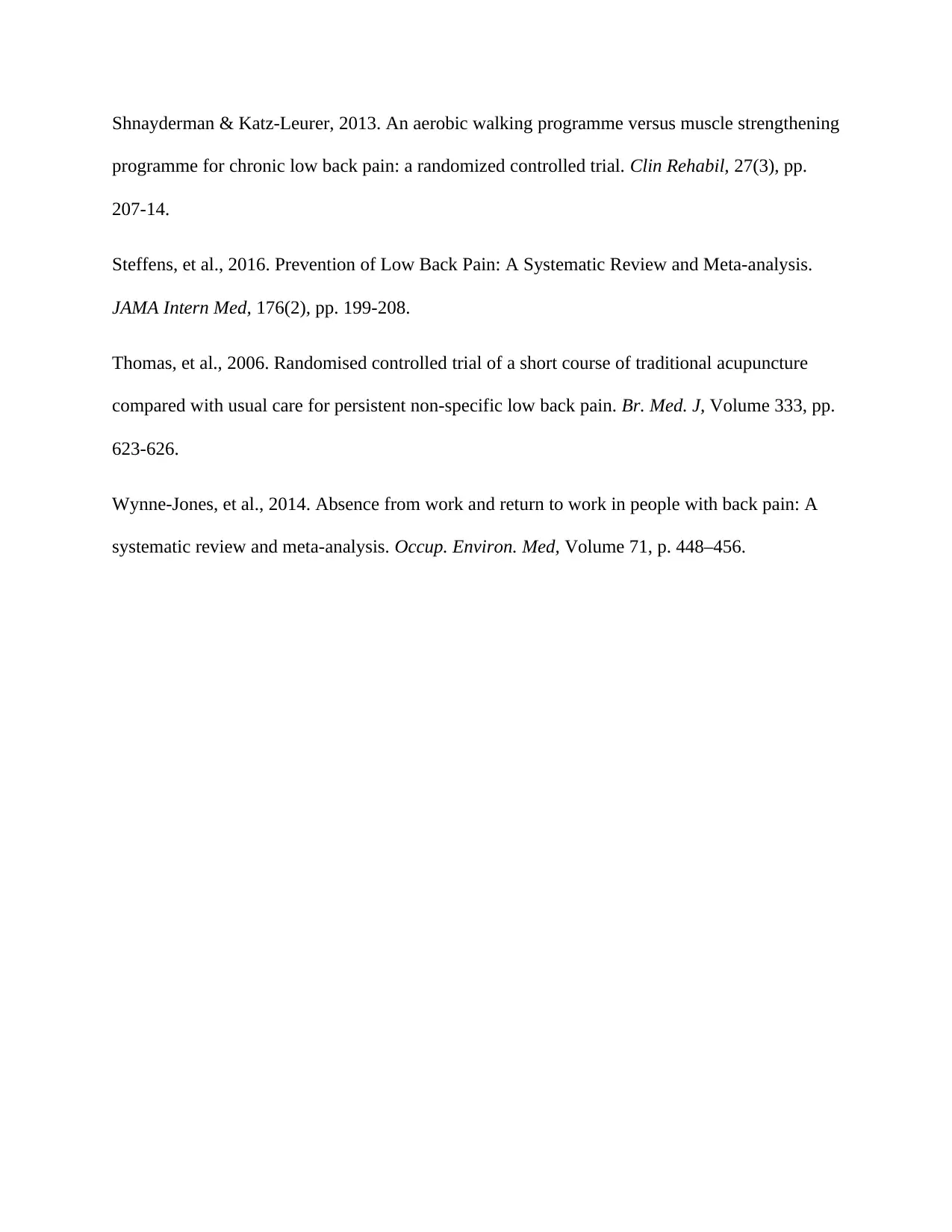
Shnayderman & Katz-Leurer, 2013. An aerobic walking programme versus muscle strengthening
programme for chronic low back pain: a randomized controlled trial. Clin Rehabil, 27(3), pp.
207-14.
Steffens, et al., 2016. Prevention of Low Back Pain: A Systematic Review and Meta-analysis.
JAMA Intern Med, 176(2), pp. 199-208.
Thomas, et al., 2006. Randomised controlled trial of a short course of traditional acupuncture
compared with usual care for persistent non-specific low back pain. Br. Med. J, Volume 333, pp.
623-626.
Wynne-Jones, et al., 2014. Absence from work and return to work in people with back pain: A
systematic review and meta-analysis. Occup. Environ. Med, Volume 71, p. 448–456.
programme for chronic low back pain: a randomized controlled trial. Clin Rehabil, 27(3), pp.
207-14.
Steffens, et al., 2016. Prevention of Low Back Pain: A Systematic Review and Meta-analysis.
JAMA Intern Med, 176(2), pp. 199-208.
Thomas, et al., 2006. Randomised controlled trial of a short course of traditional acupuncture
compared with usual care for persistent non-specific low back pain. Br. Med. J, Volume 333, pp.
623-626.
Wynne-Jones, et al., 2014. Absence from work and return to work in people with back pain: A
systematic review and meta-analysis. Occup. Environ. Med, Volume 71, p. 448–456.
1 out of 7
Related Documents
Your All-in-One AI-Powered Toolkit for Academic Success.
+13062052269
info@desklib.com
Available 24*7 on WhatsApp / Email
![[object Object]](/_next/static/media/star-bottom.7253800d.svg)
Unlock your academic potential
Copyright © 2020–2025 A2Z Services. All Rights Reserved. Developed and managed by ZUCOL.





